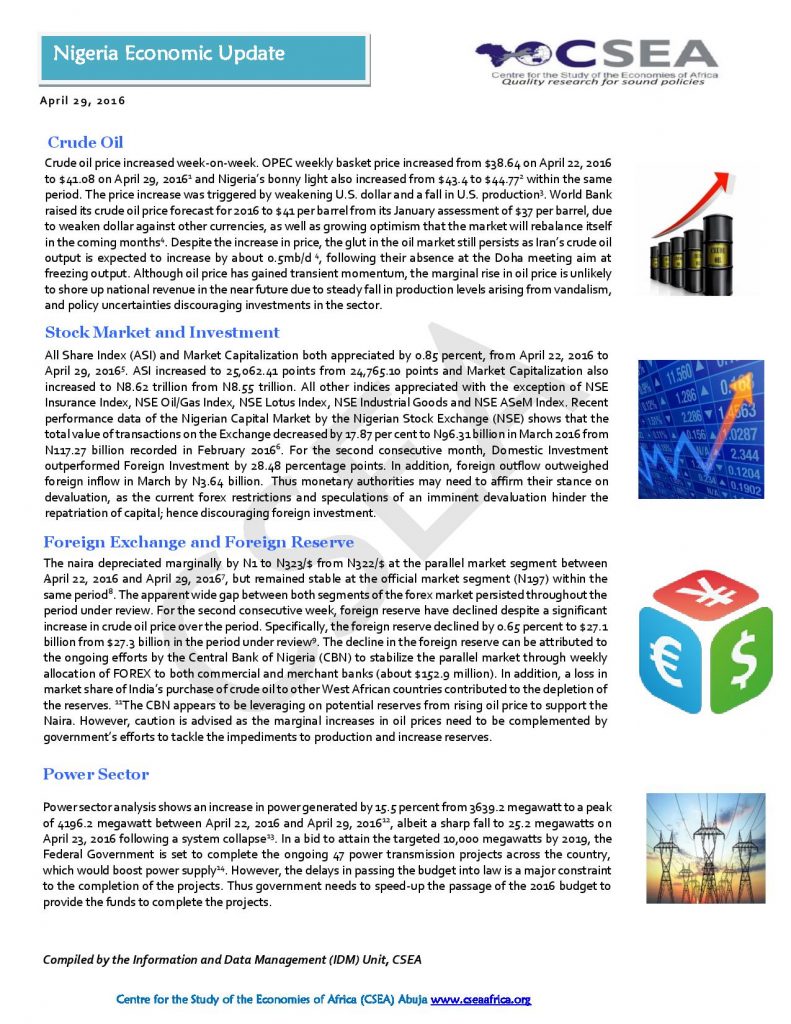Macroeconomic Report & Economic Updates

May 10, 2016
Nigeria Economic Update (Issue 20)
Power sector
analysis shows an increase in power generated by 15.5 percent from 3639.2 megawatt
to a peak of 4196.2 megawatt between April 22, 2016 and April 29, 201612,
albeit a sharp fall to 25.2 megawatts on April 23, 2016 following a system
collapse13. In a bid to attain the targeted 10,000 megawatts by 2019,
the Federal Government is set to complete the ongoing 47 power transmission
projects across the country, which would boost power supply14.
However, the delays in passing the budget into law is a major constraint to the
completion of the projects. Thus government needs to speed-up the passage of
the 2016 budget to provide the funds to complete the projects.
Related
Nigeria Economic Update (Issue 28)
Latest monthly economic report by the CBN reveals a decline in foreign exchange flows through the CBN. Foreign exchange inflow through the apex bank, dropped Month-on-Month by 21 percent to $2.3 billion in May 2017, occasioned by the fall in from Oil and Non-oil sources during the month.
Nigeria Economic Update (Issue 24)
Crude
oil price increased, in the week under review, to its highest price in 2016. Nigerias
bonny light increased by $1.38 from $48.02 per barrel on May 20, 2016 to $49.64
per barrel on May 27, 2016, while Brent crude was sold for $50 per
barrel on May 26, 2016. The catalyst for price gains in the period
under review is the supply-side contractions, with unplanned production shortages
in Nigeria, Canada and Iraq. The upward trend of prices may unlock
more supplies in subsequent weeks, but the OPEC meeting scheduled for June 2,
2016, could moderate the effect. Nigeria is expected to benefit from crude oil
price rising above the $38 per barrel benchmark. Unfortunately, supply
disruptions continue to negatively affect oil revenue and may have contributed
to the depletion of external reserve by over $153 millionthis
week. The federal government, in collaboration with relevant security agencies,
should find a lasting solution to the vandalism of oil pipelines and production
facilities.
Africa Economic Update (Issue 6)
Available data shows that headline inflation reduced in most countries in the region in May 2017 relative to preceding months. Notably, headline inflation decreased in Nigeria (16.25 percent), Ghana (12.26 percent), Tanzania (6.1 percent), Senegal (1.8 percent), Namibia (6.3 percent) and Rwanda (11.7 percent), while it grew in South Africa (5.4 percent), Kenya (11.7 percent), Ethiopia (8.7 percent) and Uganda (7.2 percent). Cote dIvoire (-0.4 percent) recorded consumer price deflation. The decrease in consumer price in Nigeria, Tanzania and Ghana can be attributed to decreases in both food and non-food components of inflation. Regionally, all countries in Southern Africa recorded single digits inflation, however consumer price marginally increased in South Africa, for the first time in 2017 owing to spike in food prices6, and Botswana (both by 0.1 percent).
